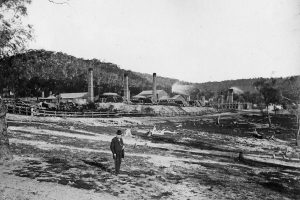In 1870 clay deposits were discovered in the Lithgow Valley in the vicinity of the Lithgow Valley Colliery. A brick and pottery works were opened there in 1877 with additional clay also being obtained from deposits near the Mt Clarence Railway Station.
After 25 years of operation, the works were enlarged with at least 80 different types of pottery being produced. Local coal was used to fuel the kilns.

Pottery making eventually declined due to an increase in the numbers of competitors in Sydney. Clay pipes however, were continued to be made to supply the local market until 1946. Brick making persisted at the site until 1977 when the site was closed by the State Pollution Control Commission (Cremin etal, 1986, p5).
Lithgow Tourism acknowledges and appreciates the History excerpts taken from the Draft Economic Development Strategy for Lithgow which was researched and compiled by Economic and Community Development Class, University of Sydney October 1996
The LITHGOW VALLEY COLLIERIES and POTTERY WORKS.

THE extensive industrial operations represented in our illustration on page 20 are of comparatively recent origin, the colliery shown being first developed about seventeen years ago. It was the first of the collieries in the Lithgow valley to connect itself by a siding with the Government main line of railway. Three or four years later, the Lithgow Valley Colliery Company decided upon the addition of brick works to their venture, and a small beginning was made, which, in progress of time, developed into the extensive works shown in our sketch.
Having succeeded in the production of sanitary and drain pipes, fire blocks, fire bricks, and tiles of every description, the Company determined to initiate the manufacture of the rougher kinds of pottery, and for several years they carried on a number of experiments, until they were in a position to put on the market goods of sufficient excellence to compete with those imported, from other countries. This they have now accomplished beyond the shadow of a doubt, although it has necessitated a serious outlay in bringing their plant and appliances up to the requisite standard. Moreover, they had to combat the customary prejudice against colonial productions, which at first materially hampered their operations, although they have lived it down, and their success may be gauged by the fact – not generally known – that there is scarcely a storekeeper in New South Wales who is not selling the Company’s goods. The estate on which the colliery, potteries, and brick-works stand covers an area of about 1,752 acres, the whole of which carries below it various seams of coal, that at present worked being about ten feet six inches in depth.
The number of hands employed in the potteries is about fifty, the brick works furnishing employment for seventy or eighty more.
The Company have also a colliery, the Hermitage, on the northern side of the line. It is on an estate of 844 acres, and is being fitted up with the ‘endless’ system of haulage, which will be in full working order about the beginning of July next. Both of the collieries owned by the Company are considered by the Government Inspector to form excellent models of mining enterprise, all the air-courses being protected with brick stoppings, and the ‘returns’ and travelling roads being in magnificent order and condition, while the whole of the appliances are as perfect as possible.
Excerpt taken from Trove Illustrated Sydney News (NSW : 1881 – 1894) Thu 7 Mar 1889, Page 19, The LITHGOW VALLEY COLLIERIES and POTTERY WORKS.



